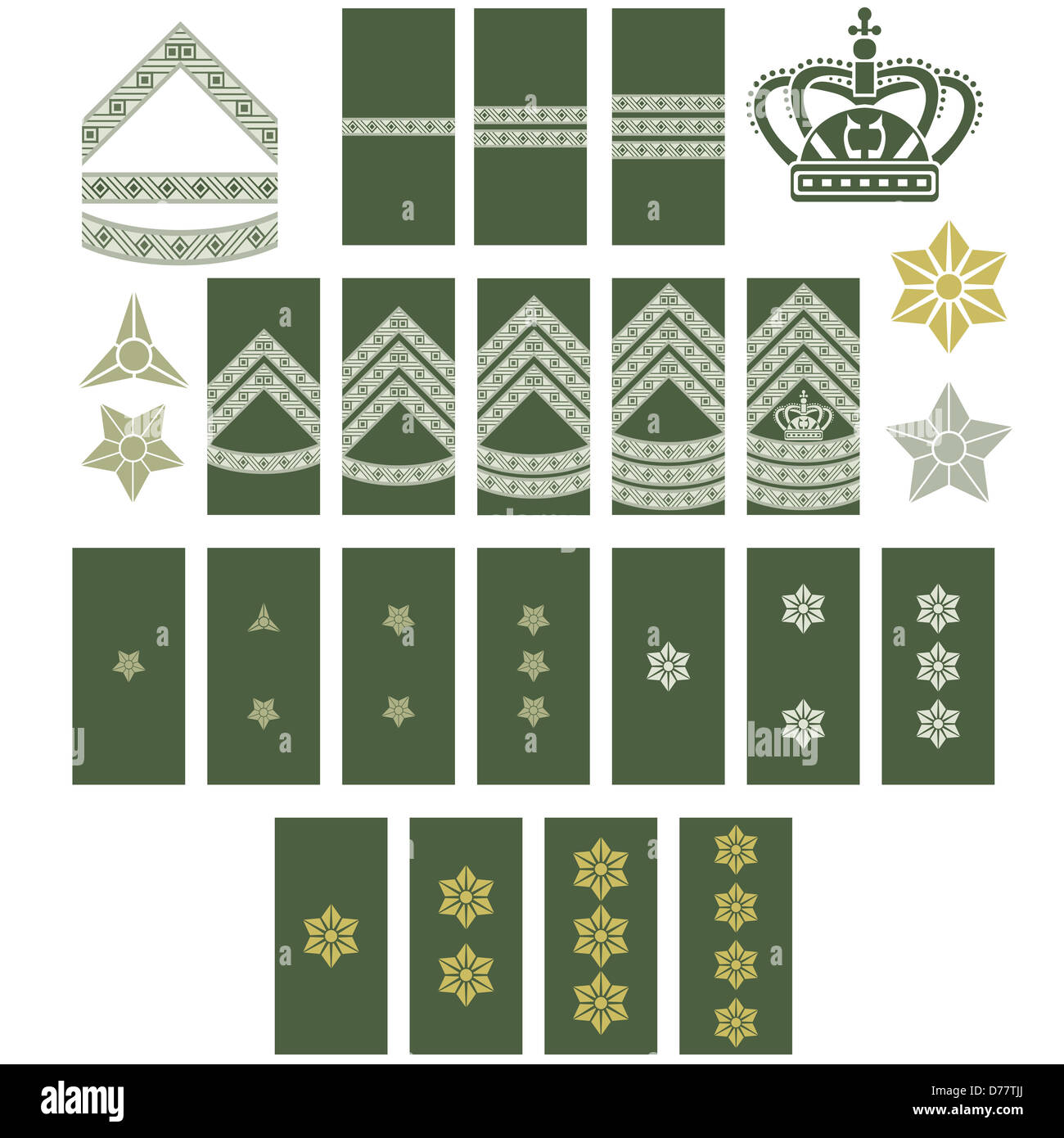Greek Military Ranks - More references are needed to confirm this story. Please help improve this article by adding quotes from reliable sources. Removing non-original material can be controversial. Find sources: "Military level" - article · newspaper · book · scholar · JSTOR (Jan 2016) (See how and who deletes this style of message)
A photo showing the ranks of several military officers from World War II.
Greek Military Ranks

Intelligence agencies or other organizations organized along military lines. Military hierarchy defines the dominance, authority and responsibility of the military system. He introduced the principles of power and the use of authority into the military chain of command - replacing the most disabled commanders as they were used. The Army's chain of command plays an important role in the implementation of the common mission.
Consumer Oriented Sales Promotion Tactics
Hierarchy has been known for most of military history to be useful in military operations, particularly in terms of strategy, command, and coordination. As time progressed, as military operations became larger and more complex, military ranks increased and the rank itself became more complex.
Ranks are used not only to select leaders, but also to determine pay levels. As the position increases, the salary increases, but so does the responsibility.
In today's military, the use of titles is almost universal. Communist states sometimes abolished ranks (for example, the Soviet Army 1918-1935,
One for each t "tribe" created by the establishment of democracy. Strategos means "army leader".
Hellenic Air Force
Often translated as "light". Initially, these houses worked together with the former polemarcho ("war lord"), but over time, the latter character entered the family: each family became a polemarch for a day, and if necessary, he would decide his fate on that day.
T gerals were equal to each other. There is no position between them, but a democratic system works: For example, at the Battle of Marathon in 490 BC, the Houses decided the war by majority vote. Each general may be assigned special duties; there was a permanent division of labor that was inevitable.
Below the general was the taxiarchos, or taxiarchos, which is similar to the modern brigadier. But Sparta was given the title of "polemarchos". Below this is syntagmatarchis, which can be translated as "leader of the state" (syntagma) and thus is the same as the modern colonel. Below him are the tagmatarchs, the commander-in-chief of the tagma (closer to a modern battalion). The position is almost identical to the standard of the Roman legions. I was followed by officer lohagos, who commanded a troop of about a hundred men called lohos, similar to a modern company led by a captain.

The Greek cavalry (hippicon) was called the hipparchia and was commanded by an epipparch. The class was divided into two houses and led by two hipparchos or hipparchus, but the Spartan horse was led by hipparmotes. Hippotoxotes was a horse archer. A Greek cavalry company was under the command of a tetrarche or tetrach.
Military Unit Hierarchy
In most Greek city-states, the military officials were composed of ordinary citizens. Armed foot soldiers are called hoplites or hoplites, and hoplomachos are instructors of training or weapons.
Once Ats became a naval power, the major land forces also controlled the ships. Under them each warship was commanded by a trierarchos, or trierarch, a word originally meaning "trireme officer" but still used for other types of ships. In addition, as with modern ships, different functions related to the ship's operations are provided by different representations. Among them, the cybernetes were speed-keepers, the keleustēs controlled the boat's speed, and the trieraules were the flute-players who kept the oarsmen's many strokes. After gaining more experience, naval tactics were replaced by Nauarchos, a naval officer equivalent to an admiral.
With the rise of Macedonia under Philip II of Macedon and Alexander the Great, the Greek army became more professional, its tactics more sophisticated, and its ranks increased. Foot soldiers are divided into large parts of the legs, called phalangites. These were among the first soldiers ever to be dug in, and they fought in close formation, usually eight meters deep, with a leader in each column (or file) and a second leader in the rear. Rows can be moved sideways if more frontage is needed.
Tetrarchia is a group of four files, and the tetrarche or tetrarch is the commander of the four files; dilochia is a double file and dilochitès is the leader of a double file; lochos a file, lochagos a leader of a file; A dimoiria is a demi-file and a dimoirite is a leader of a demi-file. Another name for demi-file is hèmilochion and hèmilochitès is leader of demi-file.
Greek Military Police
However, different types of units are divided differently, so their leaders have different titles. For example, in the numerical system of ts, dekas or dekania is the unit of t under dekarchos, hekatontarchia is the unit of hundreds under hekatontarchos, and chiliostis or hiliarchia is the unit of thousands and chiliarchos. .
Alexander (in the military) increased the number of cavalry, which became the most popular. There were large cavalry and cavalry units (ile), the latter under the command of the ilarchos.
After Marius's reforms, the Roman army began to use regular ranks. However, a comparison with the modern position is not free, because the structure of the Roman army is very different from the structure of the moderns, which arose from the beginning of modern, corporate warfare. write the fourth. Roman writers Vegetius and Caesar describe the conquest of Gaul and the civil war.
The military command was the so-called political office in Rome. Need to have a commanding outfit, politico-religious views. The king who owns it (rex sacrorum) is forbidden not to return to the kingdom. In a republic, orders are issued by councilors or (rarely) governors or in cases of necessity. Governors were used after the formation of the office. During the Empire, each army was commanded by a king, who was technically a member of parliament or ruler.
Military Rank Hd Wallpapers
The commander may appoint a deputy called a legatus. The meaning of legatus is "representative" or "army", so the connection of "legatus" with "legion" is folklore. Most of the delegates came from Rome for three years. Here the political situation of the commander-in-chief is revealed, so that the legions are always under the governor, and only the second and subsequent legions established in the same state have their own legionaries. The real commanders and agents together are the general officers in the modern system.
The governor (or his team) was immediately attacked by six tribunes (tribuni militum), five of whom were young cavalrymen and one a nobleman who was on his way to a meeting. The latter is called the laticlavian tribune (tribunus laticlavius), and the second is the order. If in modern units the deputy commander was a brigadier general, the tribune of Laticlav could be interpreted as this position, although no order was given to establish it. Other tribunes were called tribuni angusticlavii, and were equivalent to staff officers in both senior positions, lieutenant colonels, colonels, and administrative duties. They did not order to build it themselves. The word military tribune is sometimes translated into the glossary as "Colonel." In particular, the late classicist Robert Graves wrote in his translation of Suetonius' Twelve Caesars on Claudius' writings - not to be confused with the political "tribune of the people"; Additionally, they should not be confused with the "military units with consular powers" that could replace ambassadors in the early republic.
Above the tribunes of Angusticlava, the third highest officer of the army was the praefectus castrorum. He, too, would hold the rank of colonel in a modern army, but differs from the tribunes in that his office is not part of the executive hierarchy, but is often filled with ex-employees. (Modern armies have a similar distinction to a lesser extent, for example, between commissioned and non-commissioned officers.)
The m who fought in the army were "cows", formed in the ranks of the m who fought as a unit. According to Marius' new system, armies are divided into t cohorts (brains) (equal to battalions and directly subordinate to the army), each of which consists of three maniples of two types (small companies in modern parlance). each one of them. It is between 60 and 160 m. Each student was led by a kturion (translated as kturio, captain), who was assisted by a number of junior officers, including the elect. Articles are further classified as t
Ancient Greek Military Ranks Hierarchy Chart Hierarchystructure.com
Military ranks by branch, united states military ranks, army military ranks chart, military ranks air force, ranks in military marines, military ranks and pay, military general ranks, us military enlisted ranks, military officer ranks, ancient greek military ranks, military ranks, american military ranks



0 Comments